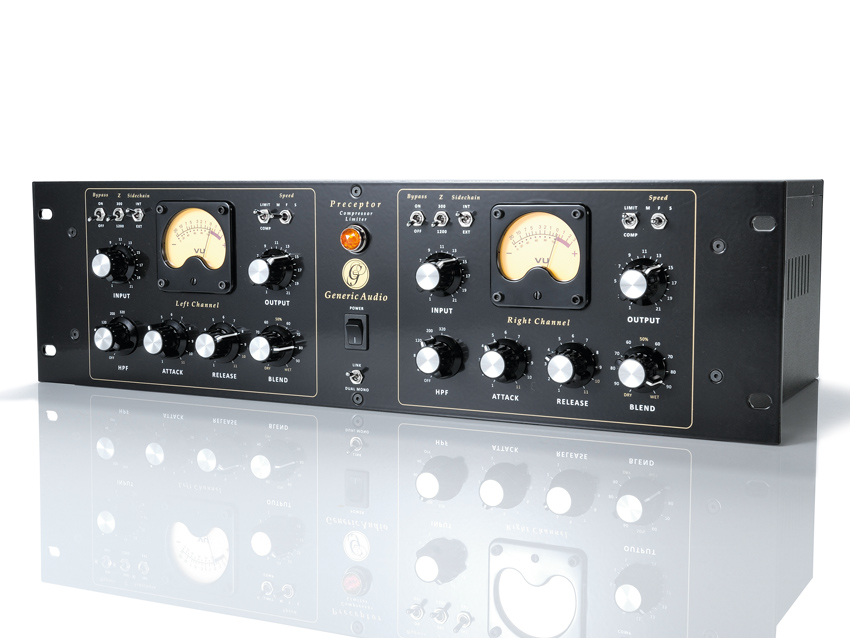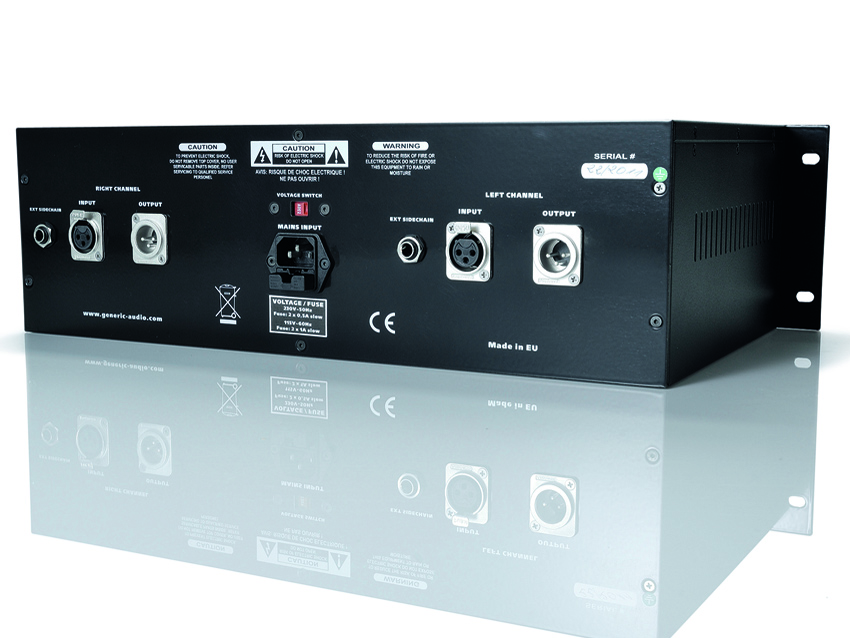MusicRadar Verdict
A serious tool for a serious price that will pay back dividends in tracking, mixing and mastering.
Pros
- +
Massive range of artefact-free gain. Superb signal quality. High-quality design and build.
Cons
- -
Hefty price tag.
MusicRadar's got your back

Generic Audio Preceptor

Generic Audio Preceptor
The Preceptor is unusually tall (3U) for a two-channel solid-state device, and though this extra headroom helps to accommodate the large power transformer, its most immediate benefit is in the front-panel design, which offers plenty of tweaking room.
The backlit VU meters not only show the gain reduction but they also indicate the bypass state, changing to an orange glow when active.
"The more time we've spent with this unit, the more we've come to appreciate it across the board."
As a 'boutique' product, this is a hand-assembled unit utilising no-expense spared components throughout: 21-position gold contact stepped attenuators, hand-matched Zener diodes and transistors, Carnhill input transformers, WIMA capacitors, and so on.
There are no continuous controls and so all settings can be recalled exactly, which makes the unit a candidate for mastering applications as well as tracking and mixing.
Generic Audio states that differences between the two channels are kept to a maximum of +/-0.1dB, which is no mean feat.
GA hasn't skimped on the power supply either, using a bespoke AC transformer (preceded by an EMI filter) to supply five separate voltages for the various circuit blocks, each of which is stabilised to within +/-0.01V.
This is crosses the borderline of obsessive, which in this context is rarely a bad thing.
The XLR inputs and outputs at the rear are accompanied by two TRS sockets for sidechain input. The sidechain selection toggle sits next to the bypass and input Z (impedance) switches at the top of each channel with two more toggle switches flanking each VU meter controlling compression/limiting behaviour and overall attack/release speed (F, M, S).
Stepped
Below the input and output controls are four more stepped rotary switches: HPF, attack, release and blend. The former engages the sidechain high-pass filter (internal and external) with five cutoff frequencies (40, 80, 120, 200 and 320Hz).
The attack and release controls provide 11 steps with automatic options at the end of the dial. The 11-position Blend knob mixes compressed and uncompressed signals in 10% steps.
Unlike many designs that use one channel as 'master' in linked stereo mode, the Preceptor only links the sidechain input (i.e. sums the two channels) allowing completely independent channel settings. This is a far preferable approach in our opinion, allowing for much more scope in tracking, mixing and mastering.
As the Preceptor does not feature a Threshold control, the input knob effectively dials in the compression/limiting click by click.
With relatively hot signals, the gain reduction meter starts dipping at the lowest input gain setting (first click up) and means you are straight into compression, though it is very subtle.
As a secondary aid to initial gain staging the input-Z switch can effectively pad back by 12dB using the
1200 tap from the transformer instead of 300. The output gain provides plenty of compensation for brutal gain reduction and with seemingly untouchable headroom.
Many devices boast higher maximum I/O figures and yet are easier to distort, so if you're a dBu spec hound don't be fooled: this is one roomy compressor.
Pumped
The Preceptor is impressively transparent and capable of adding density to a source in a flattering and musical way. Its effect is not necessarily invisible as it can easily pump like hell and remove any trace of transient life if you want it to, but it never sounds trashy or out of control.
The automatic response settings are well set up and make an excellent starting point, as well as coping extremely well with temporally complex sources such as stereo mixes and group busses.
The more time we've spent with this unit the more we've come to appreciate its abilities across the board, from instrument tracking and transient shaping (meaty drums to die for) to mix-buss and mastering duties.
For drum mixes and full stereo mixes in particular the HPF delivers all the low end back when you think you've gone a bit overboard with the dynamic range squeeze, allowing a healthy bass drum pump without killing the mids and tops.
Blended
Though we tended to use the compression setting more than limiting, the Preceptor performs flawlessly in both, with the limiting producing a more aggressive biting characteristic.
The compression is like brown sugar and can just be poured on endlessly - only when a rush of hiss comes in from the source tailing off do you realise quite how far you've gone.
The Blend function is essential with this kind of compressor/limiter and allows for some stunning parallel 'beef-ups' for all sources.
Impressed
With 'boutique' gear there's always the elephant in the room, and that is the price - which in this case puts the Preceptor shoulder to shoulder with the real big hitters.
The quality of the components and workmanship fit the (quite considerable) bill and the quality of signal path (exceptional low self noise and high headroom) in conjunction with the all-stepped controls make it a prime mastering candidate, a factor that always adds a premium.
The range of dynamic range manipulations this unit easily provides make it a highly flexible tool that can deliver excellent results in tracking, mixing and mastering environments.
We were particularly impressed by the lack of tonal colouring, a characteristic that is highly desirable and keeps it out of the one-trick-pony league.
The Preceptor is wide-ranging and yet definitively non-generic - this is what 'boutique' gear should be about.
Future Music is the number one magazine for today's producers. Packed with technique and technology we'll help you make great new music. All-access artist interviews, in-depth gear reviews, essential production tutorials and much more. Every marvellous monthly edition features reliable reviews of the latest and greatest hardware and software technology and techniques, unparalleled advice, in-depth interviews, sensational free samples and so much more to improve the experience and outcome of your music-making.
“A synthesizer that is both easy to use and fun to play whilst maintaining a decent degree of programming depth and flexibility”: PWM Mantis review
“I feel like that song had everything we needed to come back with”: Bring Me The Horizon’s Lee Malia on Shadow Moses, its riff and the secrets behind its tone, and why it was the right anthem at the right time
“I said, ‘Are we sure we can write a song about death?’”: The story of Mike + The Mechanics' classic No.1 The Living Years










